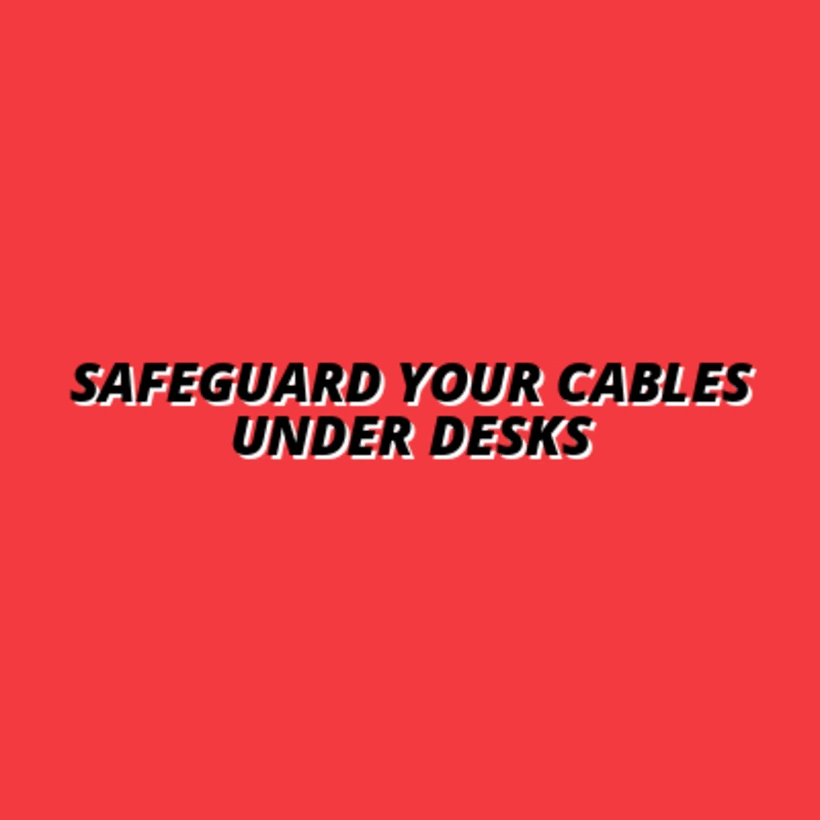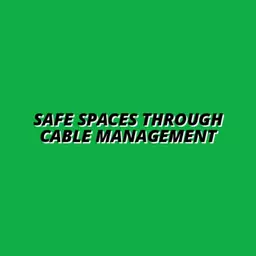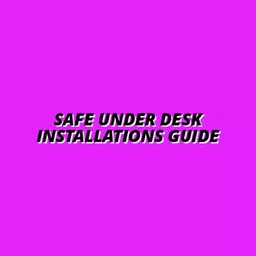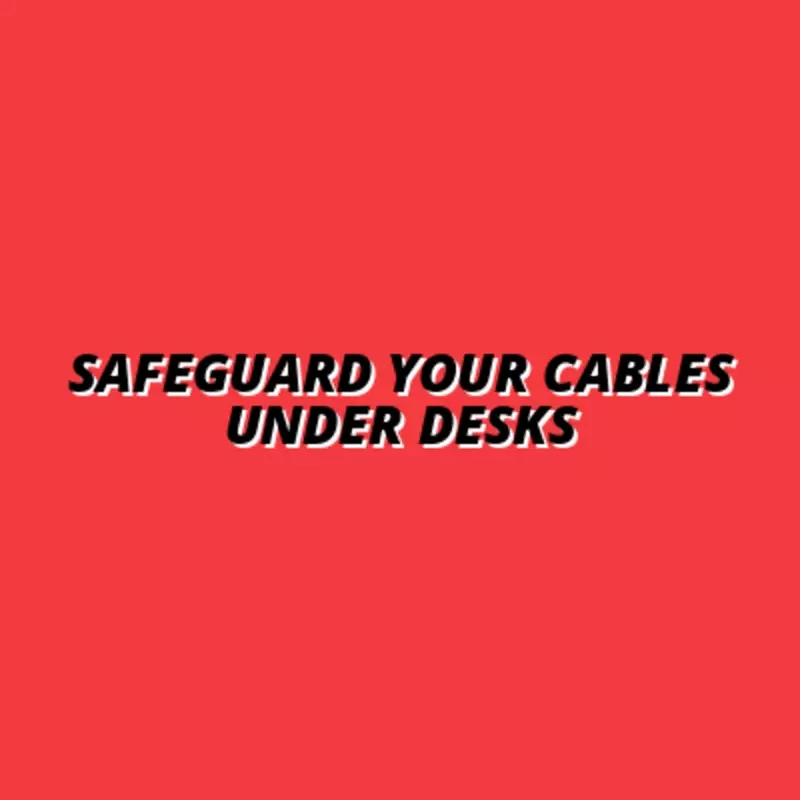
Safeguard Your Cables Under Desks
Have you ever looked down at your desk and wondered why your workspace feels cluttered? The answer could lie in the tangled web of cables beneath it. Proper cable management is not just about aesthetics; it’s essential for functionality and safety in your workspace.
What You Will Learn
- Recognize the common types of cable damage, including fraying, tangling, and crushing, to maintain a functional workspace.
- Understand the importance of effective cable management for aesthetics, functionality, and safety in your office environment.
- Explore popular cable management solutions such as cable clips, ties, sleeves, and under-desk trays to find the best fit for your setup.
- Learn how to troubleshoot early signs of cable damage and take proactive steps to prevent costly repairs or replacements.
- Discover effective methods for repairing damaged cables using electrical tape and heat shrink tubing for a quick and easy fix.
Common Cable Damage Issues and Solutions
Understanding the types of cable damage and their corresponding solutions can greatly enhance workspace safety and organization.
Common Issues
- Fraying: Worn outer insulation exposing wires.
- Tangling: Cables getting twisted and knotted.
- Crushing: Compression from heavy objects.
Repair Solutions
- Electrical tape: Wrap minor frays securely.
- Heat shrink tubing: Reinforce worn areas by applying heat.
- Replacement: Replace excessively damaged cables.
Understanding Cable Protection Needs Under Desks
When we think about our workspace, we often overlook the cables that keep everything running smoothly. However, these cables can face various types of damage if not properly managed. Common issues include fraying, where the protective coating starts to wear off, tangling, which creates an unsightly mess, and crushing, often caused by heavy furniture or improper routing. Recognizing these problems is the first step towards ensuring your workspace remains organized and functional.
Many people might not realize how much damage can occur over time. Just think about how often you pull your chair in and out, or how many times you reposition your desk. Each movement could potentially lead to cable damage! By addressing these concerns early, you can avoid costly replacements and ensure a clutter-free environment.
Identifying Common Cable Damage Issues
So, what exactly should you look out for when inspecting your cables? Here are the most common issues:
- Fraying: This occurs when the outer insulation of the cable is worn down, exposing the wires inside.
- Tangling: Cables can easily get twisted and knotted, making them hard to manage. Consider exploring simple desk cable solutions to prevent this issue.
- Crushing: Heavy furniture or poor placement can compress cables, leading to internal damage.
By keeping an eye on these common problems, you can proactively protect your cables and maintain a tidy workspace. It’s all about being aware of your surroundings!
The Importance of Effective Cable Management
Now that we know the potential pitfalls, let’s talk about why effective cable management is essential. Properly managing your cables can have incredible benefits! Here are just a few:
- Aesthetics: A neat and organized workspace looks more professional and inviting.
- Functionality: When cables are managed well, they are less likely to interfere with your movements or tasks.
- Safety: Reducing tripping hazards enhances the safety of your workspace.
At Under-Desk Tray Hub, we believe that a clutter-free desk leads to a more productive environment. When you can easily access your devices without wrestling with cords, it enhances your focus and efficiency!
Common Cable Management Solutions
So, what can you do to keep your cables safe and sound? Fortunately, there are plenty of tools available to help you manage those unruly cords! Here’s an overview of popular cable management solutions:
- Cable Clips: These small, adhesive clips can be attached to your desk or wall to keep cables in place.
- Cable Ties: Ties can bundle cables together, preventing tangling.
- Cable Sleeves: These protective sleeves cover cables, shielding them from damage and dust.
- Under-Desk Trays: These trays can hold multiple cables, keeping them organized out of sight. Learn more about plastic or metal trays safety tips for the best choice.
Choosing the right combination of these tools can dramatically improve your workspace. Remember, it’s about finding what works best for your specific setup! As someone passionate about workspace organization, I can assure you that the right tools can make a world of difference.
💡 Want to master under-desk cable trays? Start with our foundational guide to all things cable management. 👉 Read the Cable Management 101 Guide
Pro Tip
Did you know? Regularly inspecting your cables can prevent minor issues from becoming major headaches. Set a reminder to check your cables at least once a month. This simple practice can save you time and money in the long run, ensuring your workspace remains both functional and safe.
Troubleshooting Common Cable Damage Issues
Have you ever noticed your cables looking a little worse for wear? You’re not alone! Recognizing the early signs of cable damage is crucial for maintaining a tidy and functional workspace. Let’s take a closer look at how you can spot these issues before they become bigger problems.
Identifying Signs of Cable Damage
Being proactive about cable care can save you time and money. Look for these early signs of wear:
- Fraying: Exposed wires can lead to electrical hazards.
- Crushed areas: This often happens when heavy objects rest on cables.
- Tangling: Cables intertwined or knotted can cause stress and breakage.
If you notice any of these signs, it's best to take action quickly! Ignoring them can lead to more complex issues, like device failure or safety concerns.
Repairing Damaged Cables: Solutions and Tips
When you spot damage, there are several ways to address it effectively. Here are some handy solutions you can try:
- Electrical tape: For minor frays, wrapping the damaged area securely can help.
- Heat shrink tubing: This is great for protecting and reinforcing damaged sections.
- Replacement: If a cable is too damaged, replacing it may be the safest choice. It's also a good idea to consider efficient cable management for desks to prevent future damage.
Remember, a quick fix can extend the life of your cables and keep your workspace organized! Don't hesitate to tackle minor repairs yourself; it’s often straightforward and rewarding.
FAQs About Cable Management
Frequently Asked Questions
-
Q: What are the common types of cable damage?
A: Common types of cable damage include fraying, tangling, and crushing.
-
Q: Why is cable management important?
A: Effective cable management enhances aesthetics, functionality, and safety by reducing tripping hazards.
-
Q: What tools can I use for cable management?
A: Popular cable management tools include cable clips, ties, sleeves, and under-desk trays.
-
Q: How often should I inspect my cables?
A: It's recommended to inspect your cables at least once a month to catch early signs of damage.
-
Q: What can I use to repair damaged cables?
A: Electrical tape and heat shrink tubing are effective for repairing minor cable damage.
Using Electrical Tape and Heat Shrink Tubing for Repairs
Two of my favorite tools for quick cable fixes are electrical tape and heat shrink tubing! Each has its own unique benefits:
- Electrical tape: This is perfect for wrapping up small frays. It’s flexible and adheres well to cable surfaces.
- Heat shrink tubing: Ideal for reinforcing worn areas, just slide it over the damaged part and apply heat. As it shrinks, it forms a sturdy protective layer!
Using these methods not only keeps your cables safe but also enhances their longevity. At Under-Desk Tray Hub, we always recommend equipping yourself with these handy repair tools to maintain a clutter-free workspace. To ensure your workspace is safe from electrical hazards, consider reviewing electrical safety with desk trays to maintain a clutter-free workspace.
Recap of Key Points
Here is a quick recap of the important points discussed in the article:
- Recognize Cable Damage: Be aware of common issues like fraying, tangling, and crushing that can affect cable integrity.
- Importance of Cable Management: Effective cable organization enhances aesthetics, functionality, and safety in your workspace.
- Cable Management Solutions: Utilize tools like cable clips, ties, sleeves, and under-desk trays to keep cables organized and protected.
- Proactive Maintenance: Regularly inspect cables for signs of damage and address issues promptly to avoid costly repairs or replacements.
- Repair Techniques: Use electrical tape and heat shrink tubing for quick repairs to extend cable life and maintain a tidy workspace.




